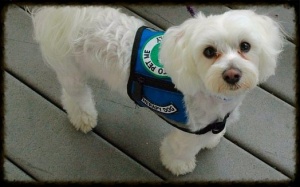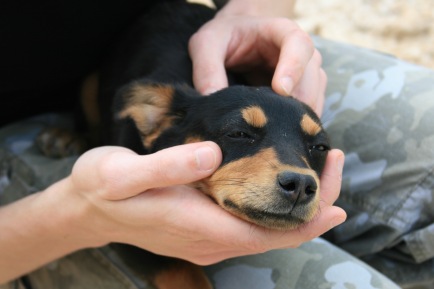A few years ago I attended a mental health conference and one of the guest speakers talked about a consumer who was enrolled in one of the mental health programs where he worked as a supervisor. This consumer had expressed a desire to get a dog to her mental health team. She was advised by her team to wait until she was more “stable in treatment” before she purchased a dog. Her team felt that she was not yet ready to take care of a pet due to her severe mental health issues.
Of course, she got the dog.
However, even though the staff were initially unhappy with the decision they supported the consumer and provided her with tools and techniques to care for her beautiful little puppy.
Then, an amazing thing happened!
Over time, the consumer showed a significant reduction in her mental health symptoms. Eventually, she was doing so well she did not need to attend her day treatment groups anymore and graduated to a less restrictive form of treatment.
The staff were amazed! What could have happened that led to this significant change?
After investigating, they found that the consumer’s relationship with her beloved dog had directly led to a positive change in the consumer’s life.
As the primary caretaker for the dog, the consumer found that she had to develop a host of qualities and characteristics.
- She had to be reliable and consistent – dogs need to be walked several times per day; many times she had to take her dog outside for a walk even though it was cold or raining because her dog required this of her to function. She had to take her dog to the veterinarian, especially during those first critical months and she had to bathe and groom the dog every month.
- She found that she had to be fiscally responsible and productive – dogs need to eat several times per day and in order to feed her dog she had to have an income. In order to have an income she had to go to work on time and behave in a productive manner while at her place of employment. She had to learn how to budget and she had to learn how to grocery shop.
- She had to be independent – she had to learn how to negotiate the public transportation system in order to get to work, get to the pet store, the vet and to the grocery store. She had to schedule appointments for her dog and find options to keep her pet happy, well nourished and healthy.
- She had to be nurturing – dogs need affection and kindness. Taking care of her dog meant that she had to learn how to manage her emotions and handle stress more effectively without taking her frustrations out on her pet.
- She had to learn how to compromise and collaborate with others – there were times that she wasn’t able to get home as quickly as she would have liked so she had to learn how to negotiate with her friends, family and work colleagues to make adjustments in her schedule when needed.
- She had to learn how to be a true friend – there were times when she wanted to be selfish and wanted to have her needs take priority over the needs of her dog but she soon came to realize that her dog was entirely dependent on her and she had to learn to behave selflessly when necessary.
After learning these skills and incorporating them effectively in her life, she developed, through her daily actions, the tools necessary for re-integration into the natural world. Because of the needs of her pet she was able to make unparalleled progress in her treatment.
This is a unique example of the role that pets have in helping individuals who suffer from mental illness. While, we don’t promise these results for everyone, we do know that pets have been shown to be beneficial in addressing mental health concerns.
- Pet owners are less likely to suffer from depression than those without pets.
- People with pets have lower blood pressure in stressful situations than those without pets.
- Playing with a pet can elevate levels of serotonin and dopamine, which calm and relax.
- Pet owners have lower triglyceride and cholesterol levels (indicators of heart disease) than those without pets.
- Heart attack patients with pets survive longer than those without.
- Pet owners over age 65 make 30 percent fewer visits to their doctors than those without pets.
- While people with dogs often experience the greatest health benefits, a pet doesn’t necessarily have to be a dog or a cat. Even watching fish in an aquarium can help reduce muscle tension and lower pulse rate.
Many of the staff within the Division of Mental Health are avid pet owners. Below, the Clinical Manager for our Adult Mental Health Program shares her story.
I would like to share with you how a flock of birds saved my life and forever changed my path. Twenty years ago I fell in love with Sugar, Barney, Pearlie, Lucy, Fred, and Tweety. These were the sweetest flock of cockatiels I had ever met. Soon after I won three more birds: Lucky, a Sun Conure; Buttercup, a Senegal; and Alex, an Alexandrine parakeet. At that time I smoked two and a half packs of cigarettes and weighed well over three hundred pounds. The first sound Alex, my parakeet, learned was my chronic cough. One day I decided I couldn’t take the guilt anymore and I informed my husband he and I were going to quit smoking. That was fourteen years ago. How about that for motivation?
As my knowledge grew through bird club involvement I became painfully aware of how fragile these creatures are to trauma and psychological damage. I was able to see the correlation between their experiences and those of the clients I serve. Cockatoos have been known to self-mutilate and demonstrate psychotic behavior. Often, their feather picking or repetitive behavior occur as a maladaptive response to previous trauma. Frequently, their hormonal cycles are interrupted by the confines of living in captivity and their natural behavior is often considered “bad” by their owners resulting in rejection and abandonment.
When Barney died, my heart was full of grief and I reached out to the Center for Avian Rehab and Education to adopt a bird. There I met Eddie, a green winged macaw. He was ten years old and had been loved by his mother but was given away when she became unable to care for him anymore. Eddie was experiencing abandonment issues and had difficulty expressing his anger. He tended to use profanity which he no doubt learned from a caretaker. He defecated all over the floor through the cage walls in what I felt was a way to offend me. He sought rejection by my husband by biting him frequently. However, when we were alone he would place his head on my heart, look into my eyes and allow me to clean his feathers. I believe God had gifted me with this bird and I made a commitment to him. I knew Eddie could live another ninety years and I wanted to be available to him for as long as I could. I decided at that time to have gastric bypass surgery. I had to get some of the weight off because I had to live to take care of these beautiful creatures. Eventually I lost 156 lbs.
I provide sanctuary for many birds. This is my passion. My energy comes from my birds. Each is special to me and has their own magic. I smile each time one of my birds sings, dances, talks or laughs. I rush home to let them out of their cages. Most can fly. Some are restricted to certain rooms due to social skills challenges. Most have few limits except for safety. Some are not tame but are trained to go back in the cage with the enticement of an almond being placed in their food bowl at bed time. I’ve learned that just like us, birds need to feel free, autonomous and in control of their environment. My stress level goes down just being with the flock. Richard always calls me “momma.” All of the other birds call me “Buttercup.” Their emotions range just like people. On one occasion when my mother walked into the bird’s room she got her feelings hurt by Berry when he exclaimed “Oh no!” I suppose he didn’t want to share my attention.
Birds and pets definitely heighten your mood. I don’t have time to allow weakness when the flock requires my strength. I have made a commitment. I believe a similar process is observed in therapy with therapy animals. In my case they increased my lifespan and improve my mental health daily.
In the Division of Mental Health we now often ask staff to find out from our consumer’s their desires, their strengths, their motivations and ultimately, their passions. In other words we ask of each consumer and staff member in the HRDI family “What’s your dog?” We ask this question because we believe that everyone has an internal motivating factor that can help them on their path to recovery from mental illness. We believe that people with mental illnesses can and do recover. We want our consumers to be intrinsically motivated to change because we believe that change that is propelled from an internal desire is change that lasts.
So, let me ask you, “what’s your dog?”
To find out more about this topic, take a look at the links below:







Loved this article-the title really caught my attention! This article will be an encouragement to many facing mental illness challenges as well as those who care for them. Keep up the good work.